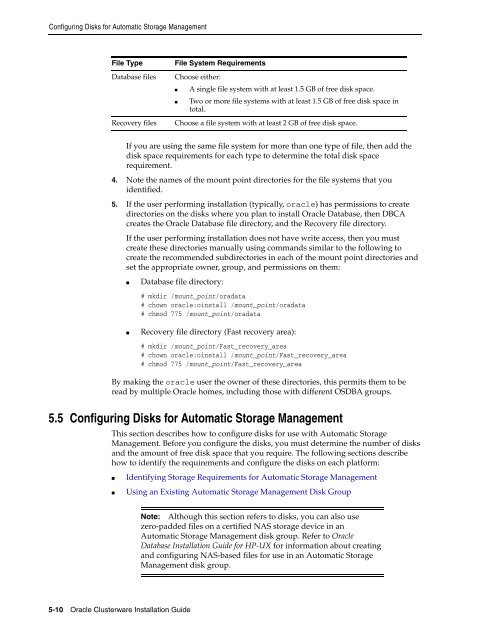Oracle Database Oracle Clusterware Installation Guide for HP-UX
Oracle Database Oracle Clusterware Installation Guide for HP-UX
Oracle Database Oracle Clusterware Installation Guide for HP-UX
You also want an ePaper? Increase the reach of your titles
YUMPU automatically turns print PDFs into web optimized ePapers that Google loves.
Configuring Disks <strong>for</strong> Automatic Storage Management<br />
File Type File System Requirements<br />
<strong>Database</strong> files Choose either:<br />
5-10 <strong>Oracle</strong> <strong>Clusterware</strong> <strong>Installation</strong> <strong>Guide</strong><br />
■ A single file system with at least 1.5 GB of free disk space.<br />
■ Two or more file systems with at least 1.5 GB of free disk space in<br />
total.<br />
Recovery files Choose a file system with at least 2 GB of free disk space.<br />
If you are using the same file system <strong>for</strong> more than one type of file, then add the<br />
disk space requirements <strong>for</strong> each type to determine the total disk space<br />
requirement.<br />
4. Note the names of the mount point directories <strong>for</strong> the file systems that you<br />
identified.<br />
5. If the user per<strong>for</strong>ming installation (typically, oracle) has permissions to create<br />
directories on the disks where you plan to install <strong>Oracle</strong> <strong>Database</strong>, then DBCA<br />
creates the <strong>Oracle</strong> <strong>Database</strong> file directory, and the Recovery file directory.<br />
If the user per<strong>for</strong>ming installation does not have write access, then you must<br />
create these directories manually using commands similar to the following to<br />
create the recommended subdirectories in each of the mount point directories and<br />
set the appropriate owner, group, and permissions on them:<br />
■ <strong>Database</strong> file directory:<br />
# mkdir /mount_point/oradata<br />
# chown oracle:oinstall /mount_point/oradata<br />
# chmod 775 /mount_point/oradata<br />
■ Recovery file directory (Fast recovery area):<br />
# mkdir /mount_point/Fast_recovery_area<br />
# chown oracle:oinstall /mount_point/Fast_recovery_area<br />
# chmod 775 /mount_point/Fast_recovery_area<br />
By making the oracle user the owner of these directories, this permits them to be<br />
read by multiple <strong>Oracle</strong> homes, including those with different OSDBA groups.<br />
5.5 Configuring Disks <strong>for</strong> Automatic Storage Management<br />
This section describes how to configure disks <strong>for</strong> use with Automatic Storage<br />
Management. Be<strong>for</strong>e you configure the disks, you must determine the number of disks<br />
and the amount of free disk space that you require. The following sections describe<br />
how to identify the requirements and configure the disks on each plat<strong>for</strong>m:<br />
■ Identifying Storage Requirements <strong>for</strong> Automatic Storage Management<br />
■ Using an Existing Automatic Storage Management Disk Group<br />
Note: Although this section refers to disks, you can also use<br />
zero-padded files on a certified NAS storage device in an<br />
Automatic Storage Management disk group. Refer to <strong>Oracle</strong><br />
<strong>Database</strong> <strong>Installation</strong> <strong>Guide</strong> <strong>for</strong> <strong>HP</strong>-<strong>UX</strong> <strong>for</strong> in<strong>for</strong>mation about creating<br />
and configuring NAS-based files <strong>for</strong> use in an Automatic Storage<br />
Management disk group.
















